Page version status
This is an accepted version of this page
| Brown | |
|---|---|
| Common connotations | |
| Autumn, Thanksgiving, earth, dirt, chocolate | |
| Hex triplet | #964B00 |
| sRGB (r, g, b) | (150, 75, 0) |
| HSV (h, s, v) | (30°, 100%, 59%) |
| CIELChuv (L, C, h) | (40, 72, 31°) |
| Source | ColorXS |
| ISCC–NBS descriptor | Strong brown |
| B: Normalized to (byte) | |
| Some shades of Brown | |
| Red Brown (X11) | |
| Pale Brown | |
| Medium Brown | |
| Dark Brown | |
| Light Brown | |
Shades of brown can be produced by combining red, yellow, and black pigments, or by a combination of orange and black—illustrated in the color box. The RGB color model, that generates all colors on computer and television screens, makes brown by combining red and green light at different intensities. Brown color names are often imprecise, and some shades, such as beige, can refer to lighter rather than darker shades of yellow and red. Such colors are less saturated than colors perceived to be orange. Browns are usually described as light or dark, reddish, yellowish, or gray-brown. There are no standardized names for shades of brown; the same shade may have different names on different color lists, and sometimes one name (such as beige or puce) can refer to several very different colors. The X11 color list of web colors has seventeen different shades of brown, but the complete list of browns is much longer.
Brown colors are typically desaturated shades of reds, oranges, and yellows which are created on computer and television screens using the RGB color model and in printing with the CMYK color model. Browns can also be created by mixing two complementary colors from the RYB color model (combining all three primary colors). In theory, such combinations should produce black, but produce brown because most commercially available blue pigments tend to be comparatively weaker; the stronger red and yellow colors prevail, thus creating brown tones.
Displayed here are some common brown shades. Some of them are associated with (any of various types of) soil, rock, or vegetation and are thus also classifiable among the earth tones.
Red-brown (web color "brown")
| Red-Brown | |
|---|---|
| Hex triplet | #A52A2A |
| sRGB (r, g, b) | (165, 42, 42) |
| HSV (h, s, v) | (0°, 75%, 65%) |
| CIELChuv (L, C, h) | (38, 94, 12°) |
| Source | X11 |
| ISCC–NBS descriptor | Vivid red |
| B: Normalized to (byte) | |
The web color called "brown" is displayed as shown.
The historical and traditional name for this color is red-brown.
The color shown above at the top right at the head of this article (color #964B00) is the color normally and traditionally regarded as brown—a medium dark orange. Its h (hue) code is 30, which signifies a shade of orange. The color to the immediate right (color #A52A2A) that was chosen as the web color "brown"—a medium dark red—is the color traditionally called red-brown. That this color is a shade of red and not orange can be easily ascertained by inspecting its h (hue) code, which is 0, signifying a shade of red.
The first recorded use of red-brown as a color name in English was in 1682.
Brown (RYB)
| Brown (RYB) | |
|---|---|
| Hex triplet | #331800 |
| sRGB (r, g, b) | (51, 24, 0) |
| HSV (h, s, v) | (28°, 100%, 20%) |
| CIELChuv (L, C, h) | (12, 19, 36°) |
| Source | RYB color system |
| B: Normalized to (byte) | |
Displayed at right is the color that is called brown in the RYB color model. It is an equal mix of red, yellow and blue.
Additional variations of brown
Rosy brown
| Rosy Brown | |
|---|---|
| Hex triplet | #BC8F8F |
| sRGB (r, g, b) | (188, 143, 143) |
| HSV (h, s, v) | (0°, 24%, 74%) |
| CIELChuv (L, C, h) | (64, 29, 12°) |
| Source | X11 |
| ISCC–NBS descriptor | Light grayish red |
| B: Normalized to (byte) | |
Displayed here is the web color rosy brown. At a hue of 359, it is classified as a red-brown.
The color name rosy brown first came into use in 1987, when this color was formulated as one of the X11 colors, which in the early 1990s became known as the X11 web colors.
Burnt umber
| Burnt umber | |
|---|---|
 Vanadinite crystals showing burnt umber coloration Vanadinite crystals showing burnt umber coloration | |
| Hex triplet | #8A3324 |
| sRGB (r, g, b) | (138, 51, 36) |
| HSV (h, s, v) | (9°, 74%, 54%) |
| CIELChuv (L, C, h) | (34, 69, 17°) |
| Source | Xona.com Color List |
| ISCC–NBS descriptor | Strong reddish brown |
| B: Normalized to (byte) | |
Burnt umber is made by heating raw umber, which dehydrates the iron oxides and changes them partially to the more reddish hematite. It is used for both oil and water color paint. At a hue of 9, it is classified as a red-brown.
The first recorded use of burnt umber as a color name in English was in 1650.
Wenge
| Wenge | |
|---|---|
 Wenge wood Wenge wood | |
| Hex triplet | #645452 |
| sRGB (r, g, b) | (100, 84, 82) |
| HSV (h, s, v) | (7°, 18%, 39%) |
| CIELChuv (L, C, h) | (37, 10, 20°) |
| Source | ColorHexa |
| B: Normalized to (byte) | |
Wenge refers to the distinctive color of the dark-colored wood that is the product of Millettia laurentii, a legume tree from Africa. At a hue of 9, it is classified as a red-brown.
Chestnut
| Chestnut | |
|---|---|
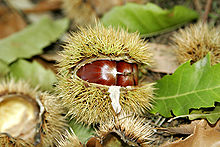 Chestnuts can be found on the ground around chestnut trees. Chestnuts can be found on the ground around chestnut trees. | |
| Hex triplet | #954535 |
| sRGB (r, g, b) | (149, 69, 53) |
| HSV (h, s, v) | (10°, 64%, 58%) |
| CIELChuv (L, C, h) | (39, 63, 19°) |
| Source | Maerz and Paul |
| ISCC–NBS descriptor | Strong reddish brown |
| B: Normalized to (byte) | |
Displayed at right is the color chestnut. At a hue of 10, it is classified as a red-brown.
Maroon
Main article: Maroon| Maroon | |
|---|---|
| Hex triplet | #800000 |
| sRGB (r, g, b) | (128, 0, 0) |
| HSV (h, s, v) | (0°, 100%, 50%) |
| CIELChuv (L, C, h) | (26, 86, 12°) |
| Source | HTML/CSS |
| ISCC–NBS descriptor | Deep reddish brown |
| B: Normalized to (byte) | |
Displayed at right is the web color called maroon in HTML/CSS and it is a brownish crimson color that takes its name from the French word marron, or chestnut. "Marron" is also one of the French translations for "brown".
Smokey topaz
| Smokey Topaz | |
|---|---|
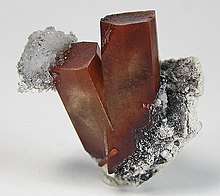 Smoky topaz crystals Smoky topaz crystals | |
| Hex triplet | #832A0D |
| sRGB (r, g, b) | (131, 42, 13) |
| HSV (h, s, v) | (15°, 90%, 51%) |
| CIELChuv (L, C, h) | (31, 72, 19°) |
| Source | Crayola |
| ISCC–NBS descriptor | Strong reddish brown |
| B: Normalized to (byte) | |
Displayed at right is the color smokey topaz. At a hue of exactly 15, it is classified as a red-brown or orange-brown. It can also be called a vermilion-brown.
This color was formulated by Crayola in 1994 as one of the colors in the Gem Tones set.
Cigar brown
| Cigar Brown | |
|---|---|
 Cigars Cigars | |
| Hex triplet | #6D4F4B |
| sRGB (r, g, b) | (109, 79, 75) |
| HSV (h, s, v) | (7°, 31%, 43%) |
| CIELChuv (L, C, h) | (37, 20, 20°) |
| Source | My Perfect Color |
| B: Normalized to (byte) | |
Cigar brown is a brown shade resembling the color of cigars.
Desert sand
Main article: Desert sand (color)| Desert Sand | |
|---|---|
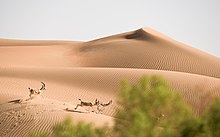 Desert landscape in the United Arab Emirates Desert landscape in the United Arab Emirates | |
| Hex triplet | #EDC9AF |
| sRGB (r, g, b) | (237, 201, 175) |
| HSV (h, s, v) | (25°, 26%, 93%) |
| CIELChuv (L, C, h) | (83, 34, 44°) |
| Source | Crayola |
| ISCC–NBS descriptor | Pale orange yellow |
| B: Normalized to (byte) | |
The color desert sand is displayed at right. At a hue of 19, it is classified as an orange-brown.
It may be publicly regarded as a deep shade of beige. It is a pale tint of a color called desert.
The color name "desert" was first used in 1920.
Dark brown
| Dark Brown | |
|---|---|
| Hex triplet | #5C4033 |
| sRGB (r, g, b) | (92, 64, 51) |
| HSV (h, s, v) | (19°, 45%, 36%) |
| CIELChuv (L, C, h) | (30, 22, 33°) |
| Source | X11 |
| B: Normalized to (byte) | |
Dark brown is a dark tone of color brown. At a hue of 19, it is classified as a black-brown.
Beaver
| Beaver | |
|---|---|
 A North American beaver A North American beaver | |
| Hex triplet | #9F8170 |
| sRGB (r, g, b) | (159, 129, 112) |
| HSV (h, s, v) | (22°, 30%, 62%) |
| CIELChuv (L, C, h) | (56, 26, 39°) |
| Source | Crayola |
| ISCC–NBS descriptor | Light brown |
| B: Normalized to (byte) | |
Beaver is a shade of brown representative of the color of a beaver. At a hue of 22, it is classified as an orange-brown.
The first recorded use of beaver as a color name in English was in 1705.
The color "beaver" was formulated as one of the Crayola colors in 1998.
Etymologically, it's believed that the words "brown" and "beaver" ultimately stem from the same root word.
Cocoa brown
Main article: Cocoa brown| Cocoa Brown | |
|---|---|
 Chocolate is created from the cocoa bean. A cacao tree with cocoa bean fruit pods (which are filled with cocoa beans inside of them) in various stages of ripening Chocolate is created from the cocoa bean. A cacao tree with cocoa bean fruit pods (which are filled with cocoa beans inside of them) in various stages of ripening | |
| Hex triplet | #D2691E |
| sRGB (r, g, b) | (210, 105, 30) |
| HSV (h, s, v) | (25°, 86%, 82%) |
| CIELChuv (L, C, h) | (56, 99, 29°) |
| Source | X11 |
| ISCC–NBS descriptor | Deep orange |
| B: Normalized to (byte) | |
Displayed at right is the color cocoa brown. At a hue of 25, it is classified as an orange-brown.
Russet
Main article: Russet (color)| Russet | |
|---|---|
| Hex triplet | #80461B |
| sRGB (r, g, b) | (128, 70, 27) |
| HSV (h, s, v) | (26°, 79%, 50%) |
| CIELChuv (L, C, h) | (36, 54, 33°) |
| Source | ISCC-NBS |
| ISCC–NBS descriptor | Strong brown |
| B: Normalized to (byte) | |
Russet is a dark brown color with a reddish-orange tinge. At a hue of 26, it is classified as an orange-brown.
The first recorded use of russet as a color name in English was in 1562.
The name of the color derives from russet, a coarse cloth made of wool and dyed with woad and madder to give it a subdued gray or reddish-brown shade. By the statute of 1363, poor English people were required to wear russet.
Russet, a color of fall, is often associated with sorrow or grave seriousness. Anticipating a lifetime of regret, Shakespeare's character Biron says: "Henceforth my wooing mind shall be express'd / In russet yeas and honest kersey noes." (Love's Labour's Lost, Act V, Scene 1)
Buff
Main article: Buff (colour)| Buff | |
|---|---|
 Buff is the color of fine undyed leathers. Buff is the color of fine undyed leathers. | |
| Hex triplet | #DAA06D |
| sRGB (r, g, b) | (218, 160, 109) |
| HSV (h, s, v) | (28°, 50%, 85%) |
| CIELChuv (L, C, h) | (70, 60, 43°) |
| Source | Maerz and Paul |
| ISCC–NBS descriptor | Light yellow |
| B: Normalized to (byte) | |
Buff is a pale yellow-brown color that got its name from the color of buffed leather. At a hue of 28, it is classified as an orange-brown.
According to the Oxford English Dictionary, buff as a descriptor of a color was first used in the London Gazette of 1686, describing a uniform to be "A Red Coat with a Buff-colour'd lining".
Kobicha (Brown-nose)
| Kobicha | |
|---|---|
| Hex triplet | #6B4423 |
| sRGB (r, g, b) | (107, 68, 35) |
| HSV (h, s, v) | (28°, 67%, 42%) |
| CIELChuv (L, C, h) | (33, 37, 39°) |
| Source | JTC |
| ISCC–NBS descriptor | Strong brown |
| B: Normalized to (byte) | |
The color kobicha (brown-nose) is displayed at right. At a hue of 28, it is classified as an orange-brown.
It is one of the Japanese traditional colors that has been in use since 660 AD in the form of various dyes used in designing kimono.
The name kobicha comes from the Japanese for the color of a type of kelp tea, but the word was often used as a synonym for a form of flattery in a curious parallel with the English usage brown nosing.
Sandy brown
| Sandy Brown | |
|---|---|
 Sand dunes in Namibia Sand dunes in Namibia | |
| Hex triplet | #F4A460 |
| sRGB (r, g, b) | (244, 164, 96) |
| HSV (h, s, v) | (28°, 61%, 96%) |
| CIELChuv (L, C, h) | (74, 81, 40°) |
| Source | X11 |
| ISCC–NBS descriptor | Moderate orange |
| B: Normalized to (byte) | |
Sandy brown is a pale shade of brown. Sandy brown is one of the web colors. At a hue of 28, it is classified as an orange-brown.
As its name suggests, it is a shade of brown which is similar to the color of some sands.
The color name sandy brown first came into use in 1987, when this color was formulated as one of the X11 colors, which in the early 1990s became known as the X11 web colors.
Peru
| Peru | |
|---|---|
| Hex triplet | #CD853F |
| sRGB (r, g, b) | (205, 133, 63) |
| HSV (h, s, v) | (30°, 69%, 80%) |
| CIELChuv (L, C, h) | (62, 75, 40°) |
| Source | X11 |
| ISCC–NBS descriptor | Moderate orange |
| B: Normalized to (byte) | |
The web color Peru has a hue of 30, and is classified as an orange-brown.
This color was originally called Peruvian brown with the first recorded use in 1924 of Peruvian brown as a color name in English.
The color name was changed to peru in 1987, when this color was formulated as one of the X11 colors, which in the early 1990s became known as the X11 web colors.
Taupe
Main article: Taupe| Taupe | |
|---|---|
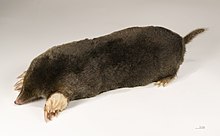 A European mole. Taupe is French for mole. A European mole. Taupe is French for mole. | |
| Hex triplet | #483C32 |
| sRGB (r, g, b) | (72, 60, 50) |
| HSV (h, s, v) | (27°, 31%, 28%) |
| CIELChuv (L, C, h) | (26, 11, 47°) |
| Source | ISCC-NBS |
| ISCC–NBS descriptor | Dark grayish yellowish brown |
| B: Normalized to (byte) | |
The color taupe is a representation of the average color of the fur of the French mole. At a hue of 30, it is classified as an orange-brown.
The color displayed at right matches the color sample called taupe referenced below in the 1930 book A Dictionary of Color.
The first use of "taupe" as a color name in English was in the early 19th century (exact year is not known).
Walnut brown
| Walnut Brown | |
|---|---|
 A bunch of walnuts A bunch of walnuts | |
| Hex triplet | #5C5248 |
| sRGB (r, g, b) | (92, 82, 72) |
| HSV (h, s, v) | (30°, 22%, 36%) |
| CIELChuv (L, C, h) | (36, 11, 52°) |
| Source | |
| ISCC–NBS descriptor | Moderate olive brown |
| B: Normalized to (byte) | |
Walnut brown is a dark brown color; a representation of the color made from walnut hulls. At a hue of 30, it is classified as an orange-brown.
Chocolate
Main articles: Chocolate (color), Black chocolate, and White chocolate| Chocolate | |
|---|---|
 Chocolate most commonly comes in three shades; dark, milk, and white varieties, with cocoa solids contributing to the brown coloration. Chocolate most commonly comes in three shades; dark, milk, and white varieties, with cocoa solids contributing to the brown coloration. | |
| Hex triplet | #7B3F00 |
| sRGB (r, g, b) | (123, 63, 0) |
| HSV (h, s, v) | (31°, 100%, 48%) |
| CIELChuv (L, C, h) | (33, 57, 33°) |
| Source | Maerz and Paul |
| ISCC–NBS descriptor | Strong brown |
| B: Normalized to (byte) | |
The color chocolate has a hue of 31, and is classified as an orange-brown.
Raw umber
| Raw Umber | |
|---|---|
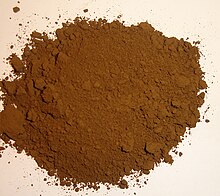 Raw umber pigment Raw umber pigment | |
| Hex triplet | #826644 |
| sRGB (r, g, b) | (130, 102, 68) |
| HSV (h, s, v) | (33°, 48%, 51%) |
| CIELChuv (L, C, h) | (45, 33, 52°) |
| Source | ISCC-NBS |
| ISCC–NBS descriptor | Moderate yellowish brown |
| B: Normalized to (byte) | |
This version of the color raw umber has a hue of 33, and is classified as an orange-brown.
Wood brown
| Wood Brown | |
|---|---|
 A wooden tree stump A wooden tree stump | |
| Hex triplet | #C19A6B |
| sRGB (r, g, b) | (193, 154, 107) |
| HSV (h, s, v) | (33°, 45%, 76%) |
| CIELChuv (L, C, h) | (66, 47, 52°) |
| Source | Ridgway |
| ISCC–NBS descriptor | Light yellowish brown |
| B: Normalized to (byte) | |
Wood brown is a color that resembles wood. At a hue of 33, it is classified as an orange-brown.
The first recorded use of wood brown as a color name in English was in Robert Ridgway's 1886 book Nomenclature of Colors for Naturalists, Compendium of Useful Knowledge for Ornithologists. Ridgway further refined the details of its color coordinates in his 1912 publication Color Standards and Color Nomenclature.
The normalized color coordinates for wood brown are identical to fallow, camel and desert, which were first recorded as color names in English in 1000, 1916, and 1920, respectively.
Tan
Main article: Tan (color)| Tan | |
|---|---|
| Hex triplet | #D2B48C |
| sRGB (r, g, b) | (210, 180, 140) |
| HSV (h, s, v) | (34°, 33%, 82%) |
| CIELChuv (L, C, h) | (75, 39, 56°) |
| Source | X11 |
| ISCC–NBS descriptor | Grayish yellow |
| B: Normalized to (byte) | |
Tan is a pale tone of brown. At a hue of 34, it is classified as an orange-brown.
The name is derived from tannum (oak bark) used in the tanning of leather.
The first recorded use of tan as a color name in English was in the year 1590.
Sepia
Main article: Sepia (color)| Sepia | |
|---|---|
| Hex triplet | #704214 |
| sRGB (r, g, b) | (112, 66, 20) |
| HSV (h, s, v) | (30°, 82%, 44%) |
| CIELChuv (L, C, h) | (33, 45, 38°) |
| Source | Maerz and Paul |
| B: Normalized to (byte) | |
Sepia is a reddish-brown color, named after the rich brown pigment derived from the ink sac of the common cuttlefish Sepia.
Khaki
Main article: Khaki (color)| Khaki | |
|---|---|
 Khaki uniform Khaki uniform | |
| Hex triplet | #C3B091 |
| sRGB (r, g, b) | (195, 176, 145) |
| HSV (h, s, v) | (37°, 26%, 76%) |
| CIELChuv (L, C, h) | (73, 28, 61°) |
| Source | HTML/CSS |
| ISCC–NBS descriptor | Grayish yellow |
| B: Normalized to (byte) | |
The web color khaki has a hue of 37, and is classified as an orange-brown. This example matches the color designated as khaki in the 1930 book A Dictionary of Color, the standard for color nomenclature before the introduction of computers.
The first recorded use of khaki as a color name in English was in 1848.
Beige
Main article: Beige| Beige | |
|---|---|
 Wool just before processing Wool just before processing | |
| Hex triplet | #F5F5DC |
| sRGB (r, g, b) | (245, 245, 220) |
| HSV (h, s, v) | (60°, 10%, 96%) |
| CIELChuv (L, C, h) | (96, 19, 86°) |
| Source | X11 |
| ISCC–NBS descriptor | Pale yellow green |
| B: Normalized to (byte) | |
Beige is a pale sandy brown color representative of the color of unbleached wool. At a hue of 60, it is classified as a yellow-brown.
Saddle Brown
| Saddle Brown | |
|---|---|
 | |
| Hex triplet | #8b4513 |
| sRGB (r, g, b) | (139, 69, 19) |
| HSV (h, s, v) | (25°, 86%, 55%) |
| CIELChuv (L, C, h) | (37, 64, 30°) |
| Source | X11 |
| B: Normalized to (byte) | |
An X11 color, Saddle Brown is a mid brown common for the stained leather of a saddle.
Manhattan
| Manhattan | |
|---|---|
| Hex triplet | #F8C898 |
| sRGB (r, g, b) | (248, 200, 152) |
| HSV (h, s, v) | (30°, 39%, 97%) |
| CIELChuv (L, C, h) | (84, 52, 49°) |
| Source | |
| ISCC–NBS descriptor | Pale light grayish brown |
| B: Normalized to (byte) | |
Manhattan is a pale light grayish brown color.
See also
References
Bibliography
- Maerz, Aloys John; Paul, Morris Rea (1930). A Dictionary of Color. New York: McGraw-Hill Book Company. LCCN 30016563. OCLC 1150631.
- 長崎盛輝 (2001). 日本の傳統色 : その色名と色調 [Traditional colors of Japan: their color names and tones] (in Japanese). Kyoto: Seigensha. ISBN 4-916094-53-0. OCLC 51110507.
- 日本色彩学会 (1985). 新編色彩科学ハンドブック [New Color Science Handbook] (in Japanese). Tokyo: University of Tokyo Press. ISBN 4-13-061000-7. OCLC 47432802.
- Ridgway, Robert (1886). Nomenclature of Colors for Naturalists, Compendium of Useful Knowledge for Ornithologists. Boston: Little, Brown and Company. OCLC 768502.
- Ridgway, Robert (1912). Color standards and color nomenclature. Washington, D.C.: Robert Ridgway. LCCN 13007093. OCLC 630954.
Citations
- "brown". Oxford English Dictionary (Online ed.). Oxford University Press. (Subscription or participating institution membership required.)
- Maerz & Paul, p. 190; Color Sample of Red-Brown: p. 33 Plate 5 Color Sample F11 (The color red-brown is listed on page 190 as a variation of the color Bole, under its original 17th-century name, “brown-red”)
- "What Colors Do You Mix to Make Brown?". Art Studio Life. September 2022. Retrieved October 13, 2022.
- Maerz & Paul, p. 191; Color Sample of Burnt Umber: p. 53 Plate 15 Color Sample A12
- "Wenge / #645452 hex color". ColorHexa. Retrieved 2023-10-09.
- "Match of Bob Timberlake™ CC-800 Cigar Brown *". My Perfect Color. Retrieved 29 December 2022.
- Maerz & Paul, p. 194; Color Sample of Desert: p. 47 Plate 12 Color Sample I7
- Maerz & Paul, p. 190; Color Sample of Beaver: p. 53 Plate 15 Color Sample A6—The color shown above matches the color sample in the book
- Harper, Douglas. "beaver". Online Etymology Dictionary. Retrieved 2012-12-01.
- Maerz & Paul, p. 203; Color Sample of Russet: p. 37 Plate 14 Color Sample I12
- R. H. Britnell (1986), Growth and decline in Colchester, 1300–1525, Cambridge University Press, pp. 55–77, ISBN 978-0-521-30572-3
- Paterson, Ian (2003), A Dictionary of Colour (1st paperback ed.), London: Thorogood (published 2004), p. 73, ISBN 1-85418-375-3, OCLC 60411025
- "buff, adj.1". Oxford English Dictionary. OUP. Retrieved 21 April 2011.
- Nagasaki (2001)
- Color Society of Japan (1985)
- Nagasaki (2001)
- Color Society of Japan (1985)
- Maerz & Paul, p. 201; Color Sample of Peruvian Brown: p. 49 Plate 13 Color Sample L11—The color Peru shown above matches the color sample in the book
- Maerz & Paul, p. 205; Discussion of Color Taupe, p. 183.
- Maerz & Paul, p. 205; Discussion of Color Taupe, p. 183; Color Sample of Taupe: p. 55 Plate 16 Color Sample A6
- Maerz & Paul; the color chocolate is displayed on p. 39, Plate 8, Color Sample H10.
- Ridgway (1886), pp. 36, 54, 117; Color Sample of Wood Brown: Plate III fig. 19
- Ridgway (1912), p. 40; Color Sample of Wood Brown: Plate XL
- Maerz & Paul, p. 195; Color Sample of Fallow: p. 47 Plate 12 Color Sample B5
- Maerz & Paul, p. 191; Color Sample of Camel: p. 49 Plate 15 Color Sample A6
- Maerz & Paul, p. 203; Color Sample of Desert: p. 47 Plate 12 Color Sample I7
- "tan". Online Etymology Dictionary. Retrieved 2011-09-13.
- Maerz & Paul, p. 205
- The color displayed in the color box above matches the colour called sepia in the 1930 book by Maerz and Paul A Dictionary of Colour New York:1930 McGraw-Hill; the color sepia is displayed on page 39, Plate 8, Colour Sample A10.
- St. Clair, Kassia (2016). The Secret Lives of Colour. London: John Murray. pp. 248–249. ISBN 9781473630819. OCLC 936144129.
- Maerz & Paul, p. 197; Color Sample of Khaki: p. 49 Plate 13 Color Sample J7
| Shades of orange | |||||||||||||||||||||||||||||||||||||||||||||||||||||||||||||||||||||||||||||||||||||||||||||||||||
|---|---|---|---|---|---|---|---|---|---|---|---|---|---|---|---|---|---|---|---|---|---|---|---|---|---|---|---|---|---|---|---|---|---|---|---|---|---|---|---|---|---|---|---|---|---|---|---|---|---|---|---|---|---|---|---|---|---|---|---|---|---|---|---|---|---|---|---|---|---|---|---|---|---|---|---|---|---|---|---|---|---|---|---|---|---|---|---|---|---|---|---|---|---|---|---|---|---|---|---|
| |||||||||||||||||||||||||||||||||||||||||||||||||||||||||||||||||||||||||||||||||||||||||||||||||||
| A typical sample is shown for each name; a range of color-variations is commonly associated with each color-name. | |||||||||||||||||||||||||||||||||||||||||||||||||||||||||||||||||||||||||||||||||||||||||||||||||||
| Color topics | ||||||||||
|---|---|---|---|---|---|---|---|---|---|---|
| Color science |
|  | ||||||||
| Color philosophy |
| |||||||||
| Color terms |
| |||||||||
| Color organizations | ||||||||||
| Names |
| |||||||||
| Related | ||||||||||
| Color classifications | |||||||||||||||||||
|---|---|---|---|---|---|---|---|---|---|---|---|---|---|---|---|---|---|---|---|
| Color systems, standards and palettes |
| ||||||||||||||||||
| Color names (alphabetic) | |||||||||||||||||||
| Variations of base colors |
| ||||||||||||||||||




